How to Unite your People and Processes with HR Tech
Let's find out the challenges of running paper-based People processes, and the benefits of investing in HR tech.
Over the past 5 years, HR technology has transformed the practice of human resource management. However, many companies still run paper-based, manual processes. In this webcast, we explore how HR tech unites employees with key processes, and why you migrate to a web-based system this year.
Watch the full webcast here:
Embedded content: https://www.youtube.com/embed/40Orm61wwBs
Download the slide deck here
Remote working is a catalyst for investment in HR Tech
Since the shift to remote working, many organizations are reviewing how they manage and communicate with their employees as paper-based processes become less and less viable. It is important to pinpoint the issues that are associated with paper-based processes and explore how HR tech can help address them.
HR technology is a way to manage employee information, company structure and key HR processes within the employee life cycle online using cloud-based software. Many businesses are investing in technology to help modernize HR to align with how people want to work and what the business needs.
74% of companies planned to increase spending on HR tech in 2020
Automating tasks with HR technology will help engage talent and improve employee experience. Whilst going paperless can pose a significant challenge which requires effort and buy-in from senior leadership, transforming HR processes with technology will achieve a high return on investment.

Challenges of Running Paper-based People Processes
Highly Dispersed Workforce
The workforce has become more and more dispersed due to increasing globalization and the overnight shift to remote working. This poses some serious problems for paper-based processes. Firstly, it is difficult to manage geographically dispersed employees when relying on a manual system. It takes much longer to gather information causing unnecessary delays for processes that would otherwise be straightforward.
Moreover, gathering information from different sources, in different locations and in different formats is an inefficient way to manage HR data. You cannot export and analyze data in real-time to share with the management team, and HR will experience difficulties generating quick and precise reports. Paper-based processes are also prone to human error, leading to inaccurate information when gathering large quantities of data from a dispersed workforce. The fragmented nature of the information will complicate processes, and HR teams will have to spend a lot of time manually sorting through the responses to draw conclusions.
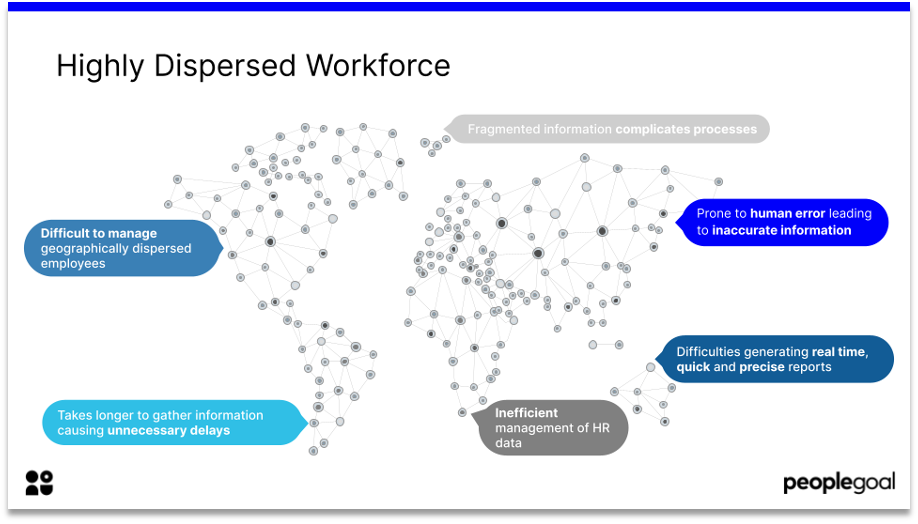
Lack of Coherent Processes
Paper-based processes require many different tools to be functional - for example, performance information might be stored on spreadsheet, and performance review instructions on a powerpoint presentation, making it difficult to have a coherent process. There is therefore a need for centralization across key performance processes.
Paper-based processes are also limited in terms of process tracking and reporting, since data exists in silos. It is impossible to generate real-time reports regarding process progress and results. Finally, paper-based processes lack a transparent mechanism for critical People processes and employee visibility is therefore restricted. Since the shift to remote working, it has become increasingly important to restore lost visibility on all fronts, especially in terms of goal setting and performance feedback.
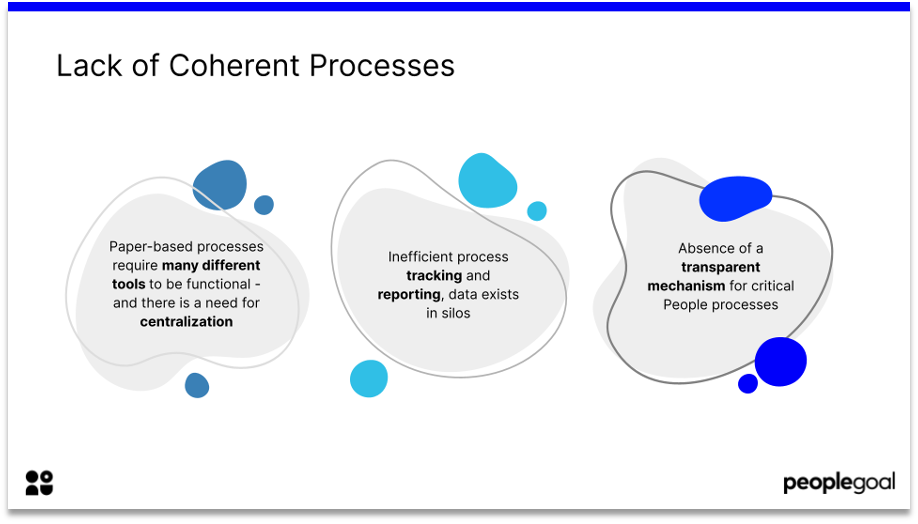
Low Engagement
Another key problem with paper-based People processes is low completion and participation rates. Research has shown that unstructured, time-consuming processes result in employees not engaging with them. This is caused by poor infrastructure, such as having complex processes that require employees to gather information from many different sources. Low engagement rates will have an impact on the wider organization as a whole, causing a stagnation of growth on both an individual and company level which will ultimately have a negative impact on profitability.
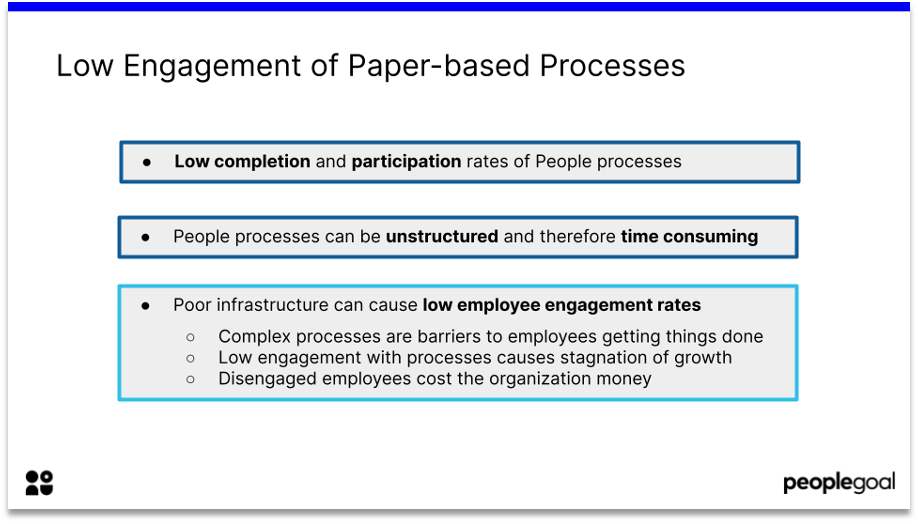
Benefits of HR Tech
A Common-place for Employee Information
HR Technology is:
• Integrated • Streamlined • Secure • Visible • Connected • Data-driven
HR tech draws together all employee data into one place, which is easily accessible by employees and managers. As we have mentioned, employee data should not exist in silos, rather, it should be integrated into one single system. Technology can also help HR to streamline processes using custom workflows, reducing the administrative burden on People Teams. For example, time-consuming, manual processes (such as sending out performance review forms) can be automated using HR tech allowing People Teams to focus on more important areas, like the processes themselves.
Technology is also beneficial in terms of security, as it helps HR departments to control and secure access to confidential information. Most online platforms are GDPR compliant and have strict privacy policies, which will ensure confidential information is protected.
HR Tech will allow for increased visibility and improve service and access to data for both employees and managers. All data will be stored in one place and will be easily accessible online. This will help connect disconnected teams, no matter where they are working, as well as help HR departments to manage employees working in diverse geographical locations and remote employees. Finally, using technology will provide well-rounded, bias free data on critical People processes, ensuring that decisions are strategic, and data driven.
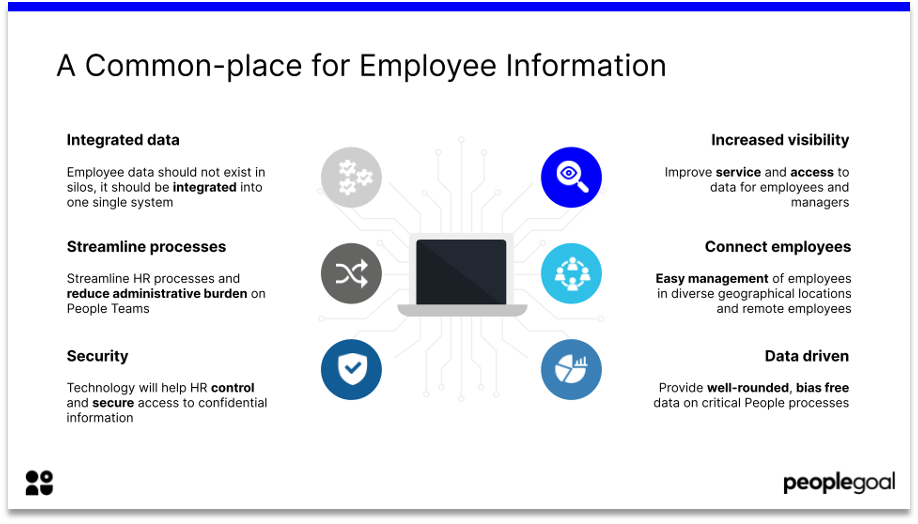
Effectively Manage the Employee LIfe-cycle
Investing in HR Tech will allow People teams to streamline all steps of the employee life-cycle, from onboarding, to performance, engagement, development and finally farewell. This will provide a positive experience to new joiners from the outset. Furthermore, encouraging regular, structured communication through an online system will have a positive impact on employee performance and development. Finally, automating repetitive tasks will free up time for HR departments, allowing them to focus on improving the employee experience journey.

Increased Engagement in Key Processes
HR Technology can trigger engagement in a number of ways:
Friendly UX: An easy-to-use, online system will encourage employees to participate in HR processes, as it is more user friendly than disparate documents and spreadsheets. It will be easier to input information, and track progress.
Personalization: Each process can be personalized to each and every employee. They will have their own portal where they can access their current items (reviews, feedback, surveys etc.), historic performance data and view upcoming processes where they need to participate.
Structured environment: HR tech allows for high visibility of performance objectives on both an individual and company level, as well as clear opportunities for development. Employees will be able to align their personal goals with organizational objectives and see how their role contributes to the overall business success. What's more, employees will have a structured development path, and better understand what their next steps are.
Continuous feedback: HR tech provides clear opportunities for employees to receive and share continuous formal and informal feedback. HR tech supports multi-directional feedback, which flows both from managers to direct reports and from employees back to the senior leadership team. It is far easier to enable a culture of continuous feedback, with regular check-ins, on the spot recognition and engagement surveys, which will ultimately increase employee engagement.
Watch our previous webcast How to Enable a Feedback Culture to learn more
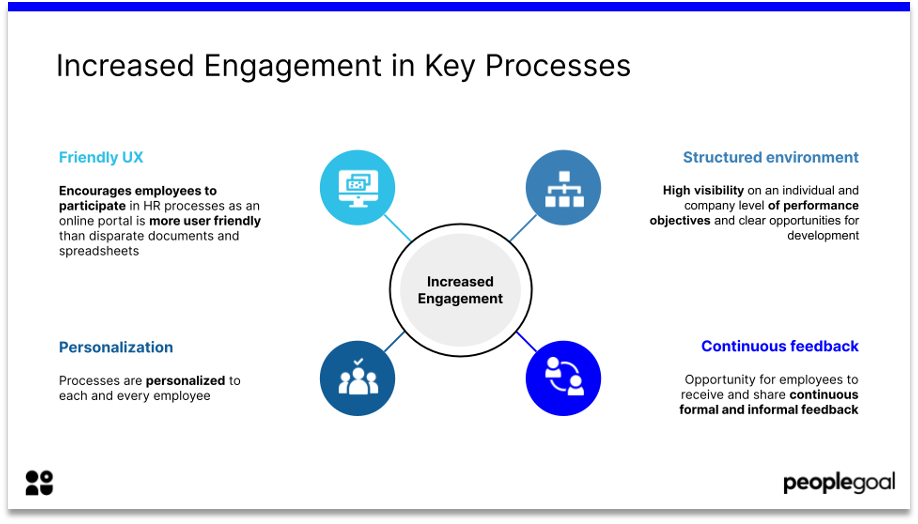
Build on a Strong Company Culture
Sound HR processes not only reflect the real drivers of company culture, but also create and improve it. Since the shift to remote working, many employees are feeling lost without the physical connection to their workspace. HR tech can play a vital role when working to restore a strong company culture in the remote environment.
Moreover, aligned and repetitive processes help shape a company's cultural identity. In essence, company culture is the set of desired behaviors and rituals encouraged my senior leadership, and it is much easier to instigate and promote these using a web-based system. By setting transparent and visible company objectives, you will allow employees to align with these goals - therefore driving employee engagement.
Company culture is an abstract concept and is difficult to measure and improve. One key benefit of HR tech is the ability to chart company culture throughout the employee life-cycle using pulse surveys and culture surveys.
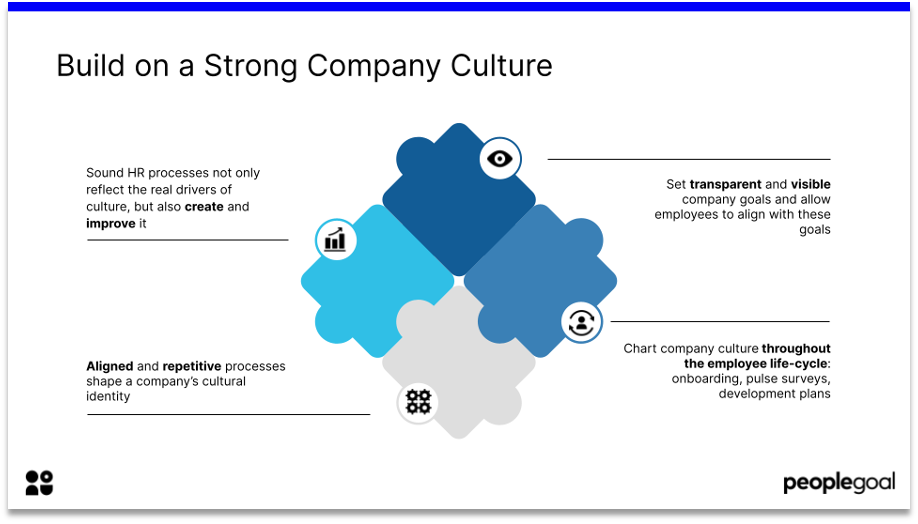
Powerful Analytics
Another major advantage of using HR technology is its ability to generate complex reports through powerful analytics. It will provide a complex and complete picture of employee performance and engagement, allowing HR departments see the "big picture". This cannot be achieved with paper-based processes, as this dynamic is only possible through technology.
Complex reporting will also accommodate real-time metrics and KPIs to allow decision makers to spot trends, and pivot quickly when faced with challenges. This will enable People Teams to manage the workforce more effectively, leverage on data and make decisions that matter.
Automated reporting enables HR to be more strategic, by making data-driven decisions based on performance data. HR will therefore spend less time compiling reports, and more time analyzing the results to drive decisions that matter most.
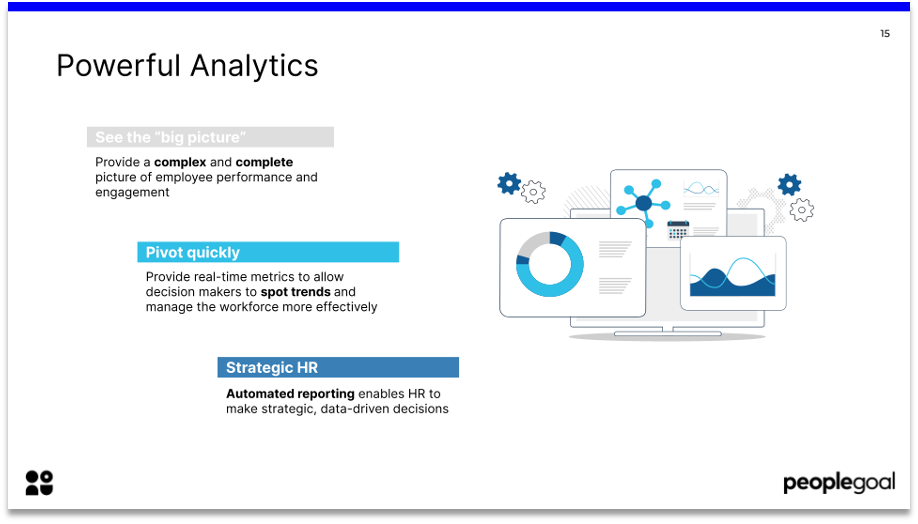
Key Takeaways
Paper-based processes are inefficient, time-consuming and therefore have low engagement rates
HR Tech brings structure to an unstructured environment, increasing HR productivity
Time saved by obsolete administrative tasks allows People Teams to focus on the employee life-cycle journey
Real-time People analytics empowers HR to make data-driven decisions around strategic employee initiatives
Want to learn more?
Enjoyed learning about HR Tech? Check out the full webcast here. If you are considering making the switch, have a take a look at our article How to Move from Paper-Based to Web-Based HR.
Need some help kicking off with your onboarding, performance, engagement and development process using a fully customizable platform? Or simply want to find out more about how HR Tech can help you? Book a demo with PeopleGoal today!
Catch up with our previous webcasts below: